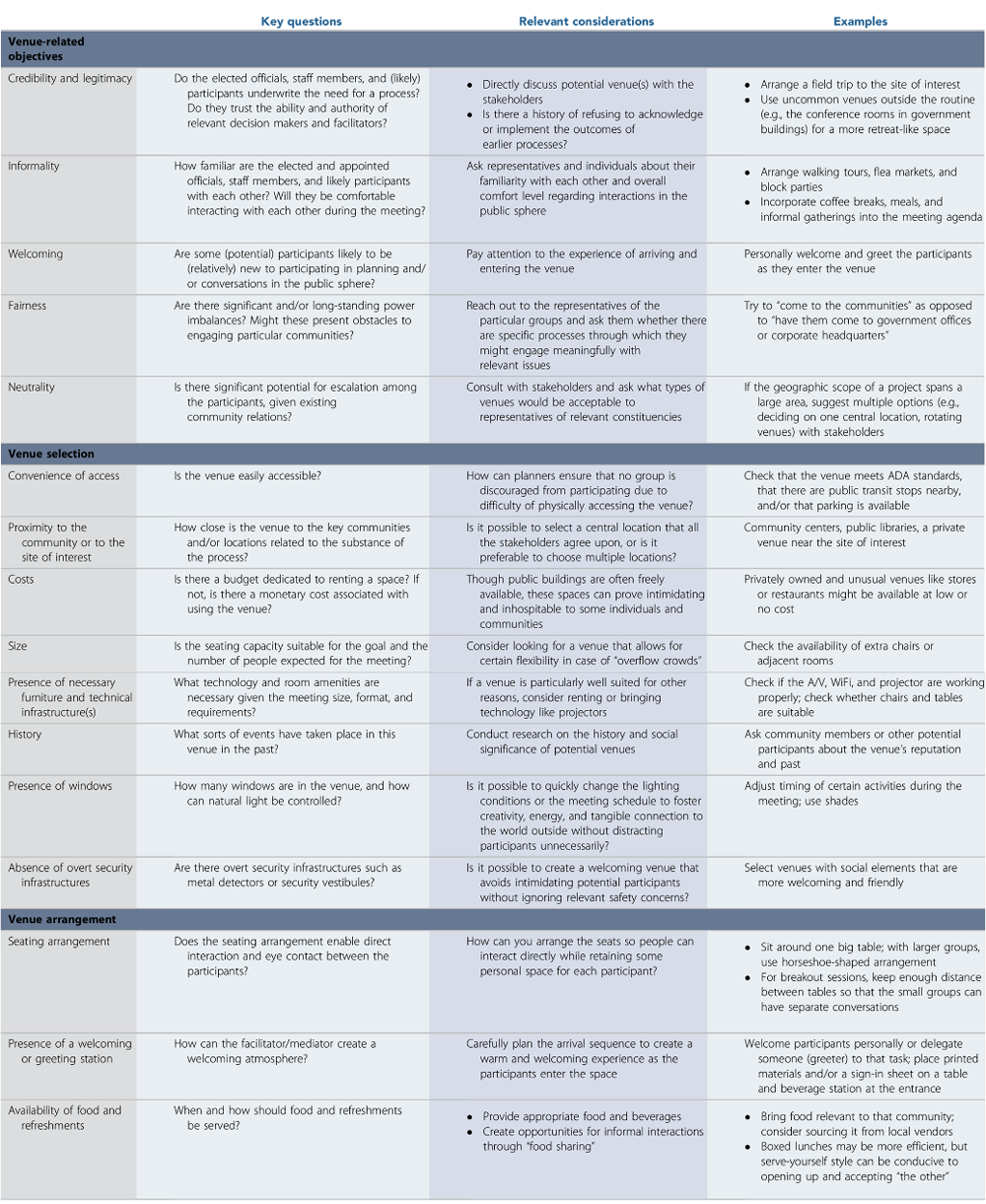Uncovering JAPA
A Guide to Choosing the Best Meeting Venues

Citizen participation and collaboration are crucial tools to enhance urban development and recognize public needs and interests. Therefore, planners often have to grapple with organizing public and stakeholder meetings as part of their daily work.
Planning Effective Civic Engagement Venues
Despite numerous guidelines and literature on civic engagement and consensus building, few studies have addressed the reasoning behind venue creation. How do planners select locations and arrange specific rooms to produce effective conversations?
To answer this question, Mattijs Van Maasakkers and Jeeson Oh interviewed 13 experienced practitioners and developed the Venue Creation Tool (VCT), outlined in "Where Should We Have the Meeting?" in the Journal of the American Planning Association (Vol. 86, No. 2).
The tool guides planners in devising effective venues for collaborative meetings focusing on three interrelated key considerations:
- venue-related process objectives
- measures in selecting a location
- space arrangement options

Table 2: Venue Creation Tool from "Where Should We Have the Meeting?" in the Journal of the American Planning Association (Vol. 86, No.2).
Optimizing Civic Engagement Venue Selection
1. Venue-Related Process Objectives
The first consideration, venue-related process objectives, refer to desired meeting dynamics such as neutrality, acceptability, comfort, or fairness.
For instance, a knee-to-knee seating arrangement will produce different behavioral dynamics and interactions compared to five-foot-apart seating. Specifically, in the case when significant power imbalances exist, the authors find that there is a potential tension that can emerge between neutral and informal venues to empower specific communities.
When neutrality is merely defined as providing equal treatment to all participants, it could prevent the most vulnerable people from engaging effectively in the process.
2. Venue Selection
The second variable, venue selection, covers the practical issues associated with choosing a location such as room size, cost, or necessary AV equipment.
Practitioners need to carefully research the social history of the venue and conduct discussions with multiple stakeholders in the process. This process is not solely to discover potential locations that may be overlooked but also to avoid certain places that will negatively affect the dynamics of the meeting.
In terms of ambiance, facilitators can decide to alternate between open and closed spaces, allowing attendees to either develop reflections on the outside world or focus on creating intimate connections inside the venue.
3. Venue Arrangement
Finally, venue arrangement relates to the elements that can be adjusted once a specific venue has been chosen.
These include seating configurations, arrival sequences, and food options. Most interviewed facilitators expressed a strong preference for a nonintimidating venue that encourages direct eye contact and interactions between the participants. A positive environment can also be achieved by simply planning the arrival sequence to welcome participants personally while also distributing printed information.
In addition, the authors propose that refreshments might contribute to a convivial atmosphere, especially when specific food items are meaningful for (some of) the participants.
Leveraging Space for Collaboration
Combining insights from existing literature and interviews with the practitioners, the authors hope that planners can utilize the tool to enhance their approach to venue creation.
These experienced facilitators are highly intentional when addressing seemingly minor details that they believe have profound impacts on the dynamics of the meetings.
As there is no one-size-fits-all approach, the venue creation strategy must be customized each time to fit the participants' backgrounds and meeting objectives. At the end of the day, the interconnectedness of physical space and subconscious human behavior should be leveraged not just by planners or facilitators, but by all professions.
Top image: Public hearing this way sign. Wikimedia Commons photo (CC BY-SA 2.0).


